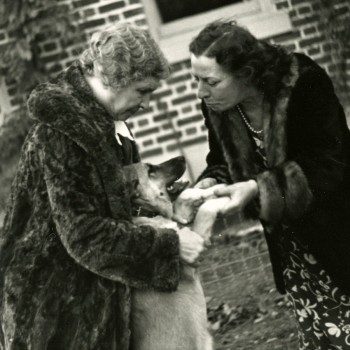
One of my heroes is Helen Keller; she did so much in spite of devastating disabilities that would have made most of us hide indoors our whole lives. If you’re unfamiliar with her story, Helen was born in 1880 as a typical child, but contracted what is now thought to be either scarlet fever or meningitis when she was 19 months old. The disease robbed her of her sight and her hearing. With a very patient teacher named Anne Sullivan, Helen was able to learn to communicate and eventually became the first deaf-blind person to earn a Bachelor of Arts degree. She went on the lecture circuit, wrote several books, and campaigned for women’s voting rights and labor rights.
All of that (and more) you could learn by watching The Miracle Worker. What’s not shown in the movie, however, are the dogs who provided Ms. Keller with companionship throughout her life. In her 1933 essay, “Three Days to See,” Keller wrote about one of the first things she would do if she suddenly had vision: “I should like to look into the loyal, trusting eyes of my dogs…whose warm, tender, and playful friendships are so comforting to me.”
Perkins School for the Blind, which she attended from 1888 to 1894, has published a pictorial essay of Ms. Keller with her dogs. She had a number of different breeds throughout her life, at one point writing, “My dog friends seem to understand my limitations, and always keep close beside me. I love their affectionate ways and the eloquent wag of their tails.” Keep in mind, this was at a point when dogs were typically thought of as a means of making a farmer’s work easier. There was no such thing as an assistance dog in the early 1900’s.
Ms. Keller is often credited with being influential in introducing the Akita to the United States, after she received one as a gift in 1937. She is pictured here with Kamikaze.
Check out the whole story, including the wonderful historical pictures, on the school’s blog.
Until next time,
Good day, and good dog!
